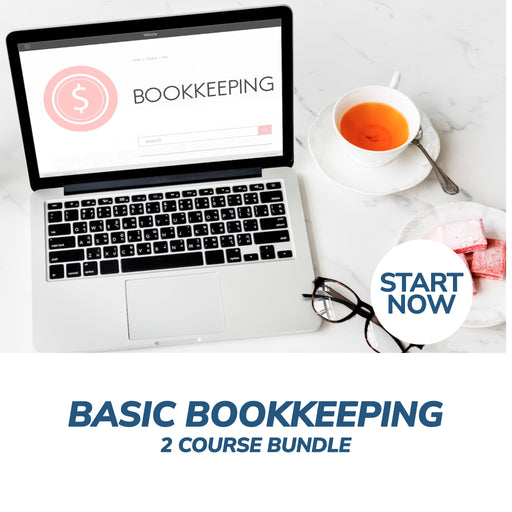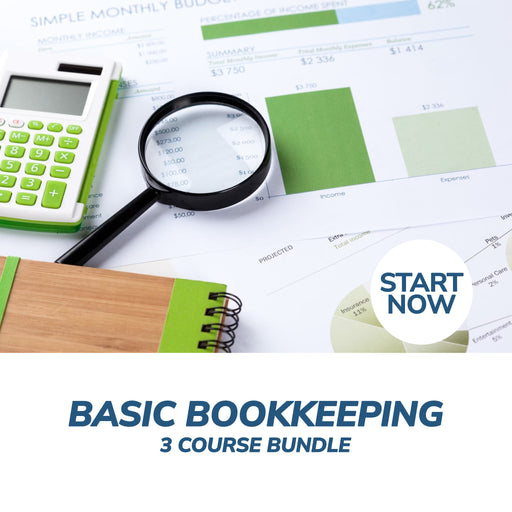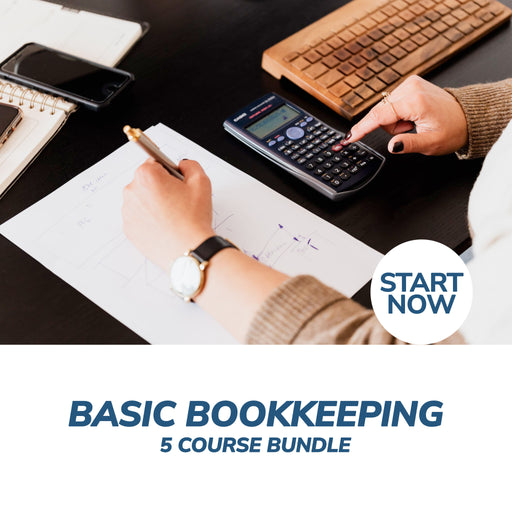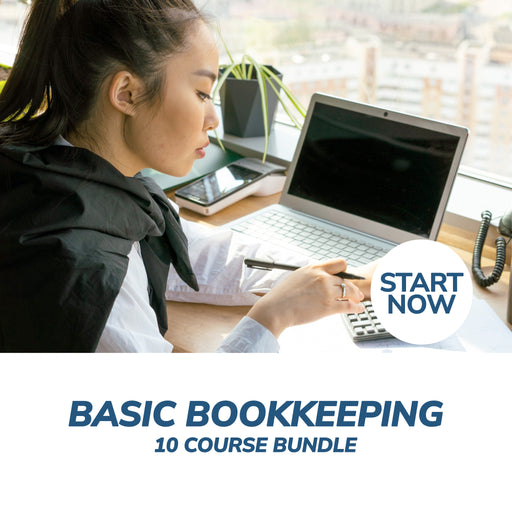Accounting & Bookkeeping Courses
-
 Save 50%
Save %
Original price USD $399Original price $399 - Original price $399Original price USD $399Current price USD $199USD $199 - USD $199Current price USD $199| /
Save 50%
Save %
Original price USD $399Original price $399 - Original price $399Original price USD $399Current price USD $199USD $199 - USD $199Current price USD $199| /Bookkeeping Online Certificate Course
"I really enjoyed learning the fundamentals of Bookkeeping as I got further into the course it gave me a better understanding of the terminology an...
View full details3 DAY SALE - ENDS 25 APRIL -
 Save 50%
Save %
Original price USD $399Original price $399 - Original price $399Original price USD $399Current price USD $199USD $199 - USD $199Current price USD $199| /
Save 50%
Save %
Original price USD $399Original price $399 - Original price $399Original price USD $399Current price USD $199USD $199 - USD $199Current price USD $199| /Bookkeeping and Accounting Skills for Supervisors Online Certificate Course
"I was originally looking for accounting courses to help me learn the basics, but I ended up finding an online course that had great reviews and ta...
View full details3 DAY SALE - ENDS 25 APRIL -
 Save 71%
Save %
Original price USD $798Original price $798 - Original price $798Original price USD $798Current price USD $229USD $229 - USD $229Current price USD $229| /
Save 71%
Save %
Original price USD $798Original price $798 - Original price $798Original price USD $798Current price USD $229USD $229 - USD $229Current price USD $229| /Bookkeeping Online Bundle, 2 Certificate Courses
Learn the Fundamentals of Balancing Your Books Bundle Up & Save - Learn More and Save More when you Upgrade to one of our Course Bundles below ...
View full details3 DAY SALE - ENDS 25 APRIL -
 Save 71%
Save %
Original price USD $798Original price $798 - Original price $798Original price USD $798Current price USD $229USD $229 - USD $229Current price USD $229| /
Save 71%
Save %
Original price USD $798Original price $798 - Original price $798Original price USD $798Current price USD $229USD $229 - USD $229Current price USD $229| /Bookkeeping and Accounting Skills for Supervisors Online Bundle, 2 Certificate Courses
Learn The Basics Of Accounting Bundle Up & Save - Learn More and Save More when you Upgrade to one of our Course Bundles below - Save Up To 98%
3 DAY SALE - ENDS 25 APRIL -
 Save 79%
Save %
Original price USD $1,197Original price $1,197 - Original price $1,197Original price USD $1,197Current price USD $249USD $249 - USD $249Current price USD $249| /
Save 79%
Save %
Original price USD $1,197Original price $1,197 - Original price $1,197Original price USD $1,197Current price USD $249USD $249 - USD $249Current price USD $249| /Bookkeeping Online Bundle, 3 Certificate Courses
Develop Your Skills to Professionally Handle Finances Bundle Up & Save - Learn More and Save More when you Upgrade to one of our Course Bundles...
View full details3 DAY SALE - ENDS 25 APRIL -
 Save 79%
Save %
Original price USD $1,197Original price $1,197 - Original price $1,197Original price USD $1,197Current price USD $249USD $249 - USD $249Current price USD $249| /
Save 79%
Save %
Original price USD $1,197Original price $1,197 - Original price $1,197Original price USD $1,197Current price USD $249USD $249 - USD $249Current price USD $249| /Bookkeeping and Accounting Skills for Supervisors Online Bundle, 3 Certificate Courses
Learn The Basics Of Accounting Bundle Up & Save - Learn More and Save More when you Upgrade to one of our Course Bundles below - Save Up To 98%
3 DAY SALE - ENDS 25 APRIL -
 Save 85%
Save %
Original price USD $1,995Original price $1,995 - Original price $1,995Original price USD $1,995Current price USD $299USD $299 - USD $299Current price USD $299| /
Save 85%
Save %
Original price USD $1,995Original price $1,995 - Original price $1,995Original price USD $1,995Current price USD $299USD $299 - USD $299Current price USD $299| /Bookkeeping Online Bundle, 5 Certificate Courses
Understand and Implement Basic Bookkeeping Principles Bundle Up & Save - Learn More and Save More when you Upgrade to one of our Course Bundles...
View full details3 DAY SALE - ENDS 25 APRIL -
 Save 85%
Save %
Original price USD $1,995Original price $1,995 - Original price $1,995Original price USD $1,995Current price USD $299USD $299 - USD $299Current price USD $299| /
Save 85%
Save %
Original price USD $1,995Original price $1,995 - Original price $1,995Original price USD $1,995Current price USD $299USD $299 - USD $299Current price USD $299| /Bookkeeping and Accounting Skills for Supervisors Online Bundle, 5 Certificate Courses
Learn The Basics Of Accounting Bundle Up & Save - Learn More and Save More when you Upgrade to one of our Course Bundles below - Save Up To 98%
3 DAY SALE - ENDS 25 APRIL -
 Save 85%
Save %
Original price USD $1,995Original price $1,995 - Original price $1,995Original price USD $1,995Current price USD $299USD $299 - USD $299Current price USD $299| /
Save 85%
Save %
Original price USD $1,995Original price $1,995 - Original price $1,995Original price USD $1,995Current price USD $299USD $299 - USD $299Current price USD $299| /Essential Accounting Skills for New Supervisor Bundle, 5 Certificate Courses
Learn The Basics Of Accounting Bundle Up & Save - Learn More and Save More when you Upgrade to one of our Course Bundles below - Save Up To 98%
3 DAY SALE - ENDS 25 APRIL -
 Save 91%
Save %
Original price USD $3,990Original price $3,990 - Original price $3,990Original price USD $3,990Current price USD $349USD $349 - USD $349Current price USD $349| /
Save 91%
Save %
Original price USD $3,990Original price $3,990 - Original price $3,990Original price USD $3,990Current price USD $349USD $349 - USD $349Current price USD $349| /Ultimate Bookkeeping Online Bundle, 10 Certificate Courses
Learn How to be Able to Keep a Close Eye on the Health of Your Business Bundle Up & Save - Learn More and Save More when you Upgrade to the Meg...
View full details3 DAY SALE - ENDS 25 APRIL -
 Save 21%
Save %
Original price USD $439Original price $439 - Original price $439Original price USD $439Current price USD $349USD $349 - USD $349Current price USD $349| /
Save 21%
Save %
Original price USD $439Original price $439 - Original price $439Original price USD $439Current price USD $349USD $349 - USD $349Current price USD $349| /Xero Accounting Online Certificate Course
"I learned a lot and will definitely apply it in working situations." - Stephen G. Verified Buyer Learn one of the world's most popular small busi...
View full details3 DAY SALE - ENDS 25 APRIL










